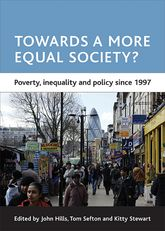Book review: Towards a more equal society? – Poverty, inequality and policy since 1997 by John Hills, Tom Sefton and Kitty Stewart
One of the many things that will stay in the mind long after this government has disappeared will be how much it liked setting targets. It wanted these to be taken seriously – after all, it was Peter Mandelson who said that Labour should be judged after ten years in office, and one of the key factors would be whether ‘Britain has become a more equal society’. A lot of the targets have been about poverty and social exclusion – and this book sets out to decide whether they have been met. Was Mandelson’s promise was worth something?
By 1997 Britian had become a pretty unequal place. In fact, of major industrial countries, it had become more unequal than any of them (except the United States) in the previous fifteen years. Not only that, but the gap between rich and poor had grown faster here than anywhere else – faster even than in the USA itself. So Labour was taking on a massive challenge.
The book spans across social policy but the chapter by Anne Power on neighbourhoods is particularly interesting to housing and regeneration professionals. She shows that, while there was yet another target (‘no one is seriously disadvantaged by where they live’), and the early years showed a confusing mix of different area-based programmes, they did in fact have an effect. The poorest areas are now better places to live in several measurable ways. Levels of resident satisfaction with them have increased a lot, even if they still haven’t caught up with the average.
While Anne Power is positive about the results of the New Deal for Communities and the many other programmes, she points out that most have now ended or have been diluted, suggesting that progress won’t be sustained. She points out that the reform of local government – passing responsibility to local level – might weaken these programmes as councils decide to spread resources more widely than before. Under Gordon Brown’s premiership, no new area programmes have been launched, despite their proven effectiveness. This suggests that the aim mentioned above about area disadvantage has been quietly forgotten.
In their overall verdict on the New Labour years, the authors are mildly positive – plenty done, but plenty still to do. The worrying thing is that advances in tackling poverty and inequality have slipped back in the last two or three years. This is partly because the economy has slowed down. But it also seems that Mr Brown’s commitment as Chancellor to targets such as eliminating child poverty has diminished now that he is at no.10 – the withdrawal of the 10p tax band was just one example.
The authors conclude that poverty can only be tackled by the sort of ‘big push’ that Labour attempted – but it simply wasn’t big enough. However, it was much better than the previous government’s policy of assuming that wealth would ‘trickle down’ as the people at the top got richer. They did, but it didn’t. Let’s hope that whoever wins the next election bears that in mind.
Original post: Housing, issue 34
